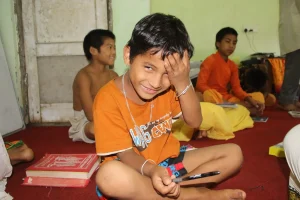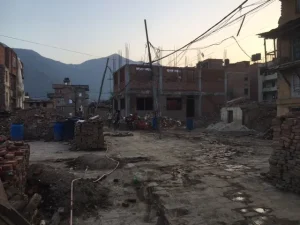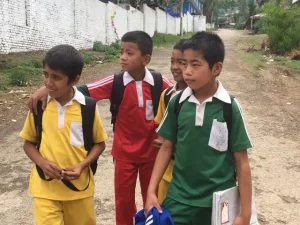After teaching a supplementary English class at Shree Baghbhairab School on Wednesday morning, I watched as students officially began their day with an assembly and singing of the Nepali national anthem. As I flipped through my notes in preparation for a meeting with the school accountant, however, something else caught my attention. In the light rain that had begun shortly after class, a young boy — no older than seven or eight — stood alone in the courtyard, crying.
As I moved towards the boy to see what was wrong, a few things stood out. The boy had two thumbs on his right hand, the result of a birth defect left unchanged because of his impoverished background (I wondered whether he might have been crying because the other children were teasing him). As he stood, he continuously uttered the word “Buba,” Nepalese for “Father.” All the while, his classmates were marching and singing less than fifty away, but it seemed as if no one in the entire school had noticed a thing.
Despite my not knowing what exactly had happened to the boy, the scene was poignant to say the least. Within the moment, though, I also found reasons to smile. Even though the boy’s classmates and teachers had all but ignored him, the young student was not alone. Next to him was one of our Nepali team members, holding the boy in her arms and remaining with him throughout the assembly. After assembly, one of my co-directors took notice of the situation and told an older student to watch out for the boy. It was a sad moment, but an unequivocally human one as well.
Our team continued its work after assembly, talking with the school accountant about lacking resources and students in the most financial need. Such information is crucial in painting a clearer picture of the school’s unique situation and formulating approaches on how to assist. However, even as we made progress in the day’s work, I couldn’t help but think about boy in the schoolyard. Why was he crying, or repeating the word “Father?” Did the older student ever remember to keep an eye out for his younger classmate?
Looking back, it is clear why the scene stood out so vividly in my memory. Among all the data, information, and numbers which our team collects, among all the discussion of making the “biggest impact possible,” the moment served as a reminder of what really matters in our line of work: People, their lives, and their stories.
In my short time in Nepal, I have managed to meet and interact with some truly incredible people. Their stories are inspiring, and show that even amidst natural disaster and lacking daily necessities, you can find strong, gracious, and honest people. One such story is that of Sukaram Tamang (a student who I mentioned in my first post), who ran away from home in the fourth grade, determined to obtain an education. Sukaram left his home, took a six-hour bus ride from his village into a densely-forested area, then walked for two days until he reached Kathmandu. After pleading with the Gorakh Nath headmaster, Sukaram was given a room in the school’s basement in which he could sleep, cook, and do his work. In return, Sukaram would perform various chores and maintenance around the school — wiring, cleaning, and anything else his teachers or headmaster could think of. Now in the tenth grade, Sukaram is a top student at Gorakh Nath, and awaits the results of his SLC exam. He hopes to enroll in +2, then attend university to study social work. When asked if he ever second-guessed his decision to leave home, his response was unambiguous: “Education is the most important thing in the world to me.”
Stories like Sukaram’s are astounding in my eyes. A young boy is denied an education by his family, walks for days to a smoggy city in search of a school to take him in, must work to live in a small room in that school’s basement, and what he wants to do with his hard-earned education is give back? Note: Perhaps “give back” is not even the proper term, as it implies that one was freely given something in the first place.
Other stories are memorable for their sheer weight and emotional impact. For example, an older student at one of our three schools is a domestic worker — a girl who does house chores and labor for a Kathmandu family in order to live in their home and receive an education. However, the girl’s host family does not want her to go to school, but instead demands she work full-time around the house. Each day the girl defies her host parents, running off to school, and each night she returns home to their (almost certainly physical) punishment. Another student, a boy, misses class to find medical care for his mother each time his alcoholic father drinks too much. A third student named Aisha was orphaned after the girl’s father killed her mother. Aisha now lives with her aunt and uncle, who punish the girl by putting a chain around her neck and keeping her outside with the buffaloes for days at a time.
Even Sukaram is not yet through the woods. His parents constantly send messages that he has had enough education and should move to a middle-eastern country to earn money as a construction worker. In addition, while he has been relying on scholarships to get him through his secondary education, Sukaram currently has no options to pay for +2.

Surveys, lists, and spreadsheet numbers are undoubtedly important to what we do. They are how we paint a bigger picture of what is happening in our schools, and how we empirically measure impact. But when talking about “big impacts” — systematic change, holistic school-oriented projects, etc. — we can easily lose sight of these deeply important stories. When talking about impacting lives, we can forget about the very lives we are trying to impact.
And what about those impacts which we cannot quantify? What about the impact of giving Sukaram a scholarship for his +2 studies, allowing him to continue towards his dream of helping countless other Nepali people as a social worker? What about giving Aisha an opportunity for a better future, so she might one day give her own children the safe and loving family which she has been deprived of? Ultimately, each outcome would represent just one tick mark on the datasheet of our entire organization’s work. But in reality, they are not simply outcomes. These are peoples’ lives.
As I think back to that boy crying in the Shree Baghbhairab schoolyard, I am convinced that this mindset will be invaluable to Reinstalling Hope as we move forward. Yes, we want to enable each Nepali student who dreams of a quality education to receive one. Yes, we want government schools to keep students’ best interests at heart, and their teachers to feel respected and well-equipped to do their jobs. We also want to eventually take on more schools and impact as many lives as possible. But we cannot forget that success will not simply be measured in statistics, charts, or figures. These are only representations of impact; they are not what we work for. We work for impoverished Nepali students: Their goals and their dreams, their lives and their stories. Far above any numbers or data, these unmeasurable, intangible things are what truly matter to us in the end.
Originally published at http://wantinghumility.wordpress.com on May 28, 2016.





